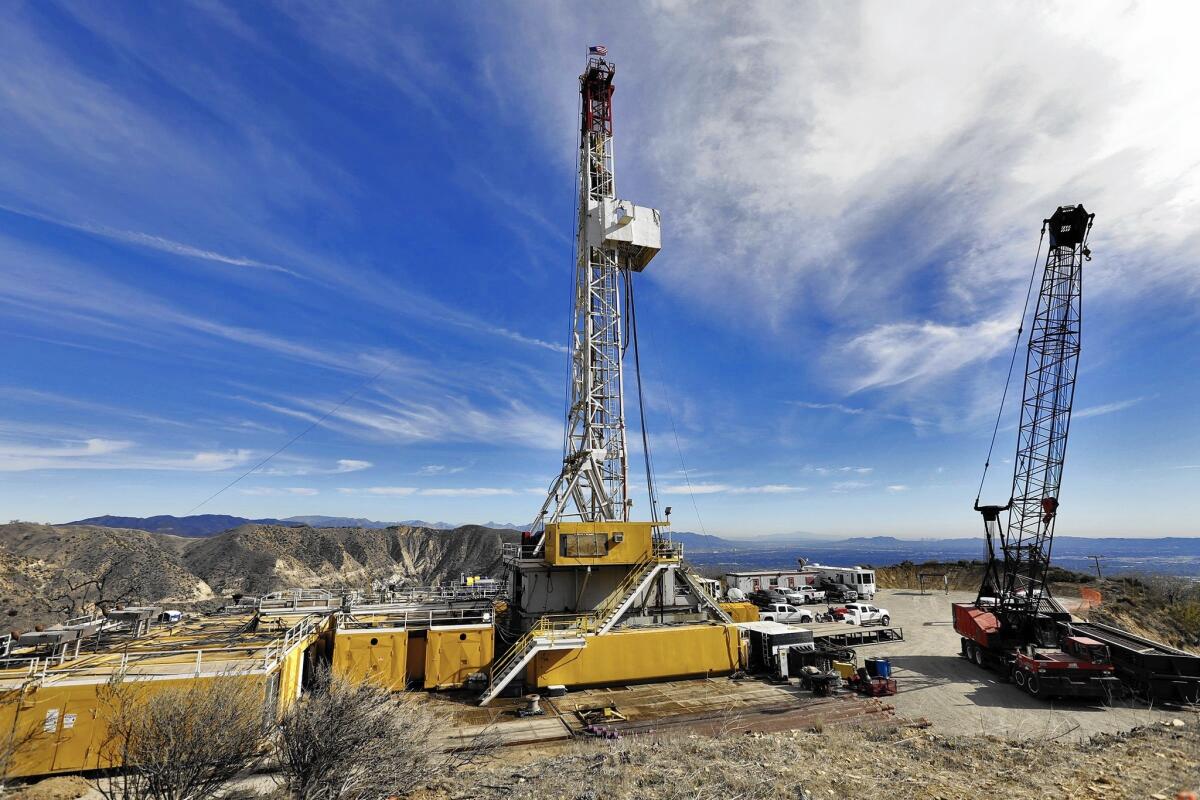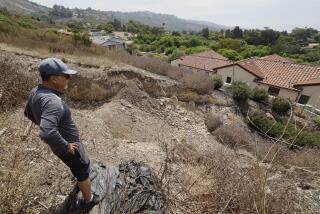‘This is a threat. This is not a report.’ Critics call blackout warnings a scare tactic to keep Aliso Canyon open

If energy agencies and utilities ever want to scare consumers, they need say little more than “blackouts.”
Those rolling power outages, well remembered from the state’s energy crisis of 2000-01, sit at the heart of the case California energy officials are making to keep the troubled Aliso Canyon natural gas storage facility open after the worst leak by such an operation in U.S. history. But doubts are growing about warnings that Southern California could face blackouts this summer without Aliso Canyon, contained in a report released last week by California energy agencies.
Consumer groups and utility critics contend that the blackout warnings are an irresponsible scare tactic to ensure that Southern California Gas Co. is allowed to keep storing gas at the facility and that ratepayers will pay for upgrades to store even more fuel there. Detractors say the report fails to mention additional natural gas fields as well as other fuel and power options that could help keep the region’s lights on this summer.
“The people who control blackouts are threatening blackouts if they can’t keep Aliso open. This is a threat. This is not a report,” said Michael Aguirre, a former San Diego city attorney and a longtime adversary of state energy regulators and the utility industry, which he and others contend have an inappropriately cozy relationship.

The Aliso Canyon gas storage facility, the largest in the state, drew national scrutiny when a four-month leak forced residents in nearby Porter Ranch from their homes, some complaining of headaches and nosebleeds.
Gov. Jerry Brown ordered a moratorium on injecting gas into the storage operation until Southern California Gas ensures that the wells are safe, a process that could take months. The storage plant still holds about 15% of the facility’s natural gas capacity, and those depleted supplies could pose a problem in the months ahead, energy officials say.
Southern California will need Aliso Canyon this summer and beyond to help keep electricity flowing during high demand as air conditioners fire up and gas-fueled power plants are called into service on short notice, according to the report. The California Energy Commission, California Public Utilities Commission and the California Independent System Operator, which manages the state’s electricity markets and most long-distance transmission lines, released the report last Tuesday. Southern California Gas and the Los Angeles Department of Water and Power also were involved in producing the 56-page report.
See more of our top stories on Facebook >>
If no fuel can be withdrawn from Aliso Canyon, a natural gas shortage could force rolling blackouts during as many as 14 days this summer plus an additional eight to 18 days later in the year. The contributing factors, the report states, are conflicts in scheduling of gas deliveries on the pipeline system, daily demand for gas and outages at other storage facilities.
The report notes that Southern California Gas’ other storage fields are too small, too remote or too busy serving other areas to help plug the L.A. basin’s supply gaps. Those limitations, the agencies contend, could make it difficult to send enough natural gas to the region’s 17 gas-fueled power plants.
A rebuttal report issued by advocacy organization Food & Water Watch argues that the energy agencies’ conclusions “are based on inflated estimates of the demand for electric power, underestimates of the capacity of other SoCalGas gas storage facilities, and other unsubstantiated or flawed data.”
Congestion on the region’s pipeline network shouldn’t be a problem, the group said, because the system has never reached capacity in the last decade. The organization says, for instance, that the highest Southern California Gas peak summer demand over the 10 years was 3.7 billion cubic feet a day, less than the maximum capacity of 3.875 billion cubic feet.
But congestion isn’t the only snag, said Terri Prosper, a utilities commission spokeswoman. Natural gas can be slow to ride to the rescue when a power plant is needed quickly.
“Because gas travels through pipelines at a relatively slow rate, approximately 30 miles per hour, rapid changes in demand at these plants quickly draws down supply in the pipeline; operating pressures in the line drop and must be replaced quickly both to maintain operating pressure and continue to meet demand,” Prosper said. “Aliso is the only facility close enough to respond on a timely basis.”
Among the state report’s other flaws, critics said, was the failure to mention that many of the region’s 17 power plants are run by municipalities that own a natural gas field in Wyoming. Field owners DWP, Burbank, Glendale, Pasadena, Colton and the Turlock Irrigation District are part of a consortium called the Southern California Public Power Authority.
The municipalities, led by DWP, bought ownership in the Wyoming field in 2005 “to further stabilize the single most volatile component of DWP’s operating expenses, thereby helping DWP achieve its goal of maintaining stable retail electric rates for our customers,” the department said in a statement at the time.
The Wyoming field was expected to initially provide 12% of DWP’s natural gas supply, with future growth expected. However, the field supplies only 10% of DWP’s natural gas to four power plants on the municipal utility’s system.
A 2012 audit recommended that DWP do even more to diversify and “should consider alternative supply basins and pipelines … to plan for unforeseen interruptions” — the kind of interruption the state’s energy agencies now say could be imminent without Aliso Canyon. That diversification hasn’t happened.
The ability to get natural gas from the Wyoming field “is a material fact that should not have been left out of the report because it leaves the reader misled,” said Aguirre, the San Diego lawyer.
Bill Powers of Powers Engineering in San Diego, who wrote the Food & Water Watch document, added that reliance on Southern California Gas to manage all L.A. basin natural gas pipelines has made the system vulnerable to interruptions.
“The only thing keeping that gas [in Wyoming] out of the system is the transportation system,” Power said. “The band leader of that transportation system is SoCal Gas.”
The California Energy Commission dismissed the Wyoming natural gas field as a significant factor in helping resolve blackout concerns.
“The fact that DWP and the SCPPA members together own natural gas reserves in Wyoming is not relevant to the technical report or the action plan,” said Linda Rapattoni, an energy commission spokeswoman. “Ownership of reserves does not provide higher priority of service” on a pipeline network that must serve many customers.
For its part, DWP said it has worked to follow the audit’s recommendations but hasn’t found a cost-effective solution.
“We did look for additional storage options,” said Michael Webster, DWP’s executive director of engineering and technical services. “Since 2012, we just have not seen any opportunities.”
Southern California Gas said its other three storage facilities are incapable of replacing Aliso Canyon.
A Playa del Rey storage field, which is closest to many of the power plants, is too small, Southern California Gas said. Its La Goleta field in Santa Barbara County is too remote, the utility said.
Its second-largest storage facility, Honor Rancho, is about a third the size of Aliso Canyon and sits about 10 miles north of it. Southern California Gas argues that Honor Rancho cannot provide natural gas in place of Aliso Canyon because it is supplying fuel to the San Joaquin Valley and other areas to the north and on the coast.
But when asked for specific amounts of natural gas sent to those areas, the company couldn’t provide details.
“It is not possible to determine what natural gas goes to what location,” said Tammy Taylor, a spokeswoman for Sempra Energy, the parent company of Southern California Gas.
Another report omission, the critics said, was the ability of power plants to use fuel other than natural gas.
DWP’s 800-megawatt Scattergood power plant uses a byproduct from the Hyperion Waste Water Treatment Plant, called digester gas, a combination of methane and carbon dioxide. Two of Scattergood’s three units run on the alternative gas. But the report doesn’t discuss this.
Power plants also could store backup fuel but stopped doing so after they were forced to abandon oil as a substitute to reduce emissions, Powers said. Utilities could store Amber 363, a synthetic diesel used as an alternative to natural gas by the Orange County Central Utility Facility and UC Irvine gas turbine cogeneration plants, he said, adding that Amber 363 doesn’t produce significant emissions.
“Once you take away that backup gas, you are dependent on one fuel, and that should not happen,” Powers said.
Twitter: @ivanlpenn
ALSO
Chinese investors love California, but they’re putting money elsewhere in the U.S. too
Switch to Frontier causes glitches for some former Verizon customers
Patients increasingly rely on mobile health apps, but their reliability is an issue
More to Read
Inside the business of entertainment
The Wide Shot brings you news, analysis and insights on everything from streaming wars to production — and what it all means for the future.
You may occasionally receive promotional content from the Los Angeles Times.











